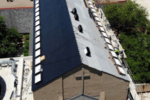May 2005
Buildings and Grounds
God is in the Details
A storm spinning thousands of miles over the Pacific Ocean drives ahead of it warm but powerful southerly winds and dark, foreboding skies. On this late Sunday afternoon most people have already retreated indoors. I can smell wood smoke in the air and damp earth.
I stand at the edge of the lower lawn where newcomers to this church make their first friends during our summer picnics. Some of us dream that the barbecue area on my right will one day be an outdoor labyrinth for walking and praying. Across from here lie the gates to the columbarium where many who led and loved this church are buried.
Two families chose this day to plant three Coast Redwood trees. As I rest on my shovel and our children play in the dirt, it suddenly occurs to me that for many this may be the holiest place on the church campus. The magnitude of what we are doing begins to sink in.
The trees we plant could die from neglect during a hot summer or they could be alive and exist longer than anything that we do, make or even touch. Biologists will not consider these trees mature until sometime between the year 2500 and 2600 A.D.
Some living redwood trees are older than the church. The oldest one lived for 2200 years. The world’s tallest tree at 368 feet is a redwood. As we carry these trees up the hill for the glory of God we come close to eternity.
One could say this about almost every place on the church campus. Every observable detail says something about our relationship to each other and to God. The immaculate chapel sacristy, the cluttered parish hall, the broken floor tiles in the Sunday School classrooms, our street signs (and no skate-boarding signs), the fraying carpet in the sanctuary and expansive grounds all say something about who we are and about our commitment to God.
Whether we intend to or not, our belief in God becomes incarnate in a thousand details that we may not even notice anymore. They say whether we are welcoming or self-satisfied, whether this is a place that people are passionate about right now or one whose glory days are long over. In the most practical sense they show that we care about making God accessible to children and the disabled, or that we are only concerned about people like ourselves.
Last winter a family at our church contributed money to redo the floor and paint the fireside room. With the help of a vestry member, the family also installed a gas fireplace. This cozy place communicates volumes to the families now visiting us in order to learn about our new preschool. I believe that people participating in small groups there are now more likely to experience the love of Christ.
As the storm continues to gather force and the first rain drops fall, we finish planting our redwood trees — but we do not cease to participate in making God’s love known through the objects that surround us.
The Rev. Dr. Malcolm Young is rector of Christ Episcopal Church in Los Altos, California. In September of 2004, he received his doctoral degree in theology from HarvardUniversity where he wrote a dissertation on Henry David Thoreau.





